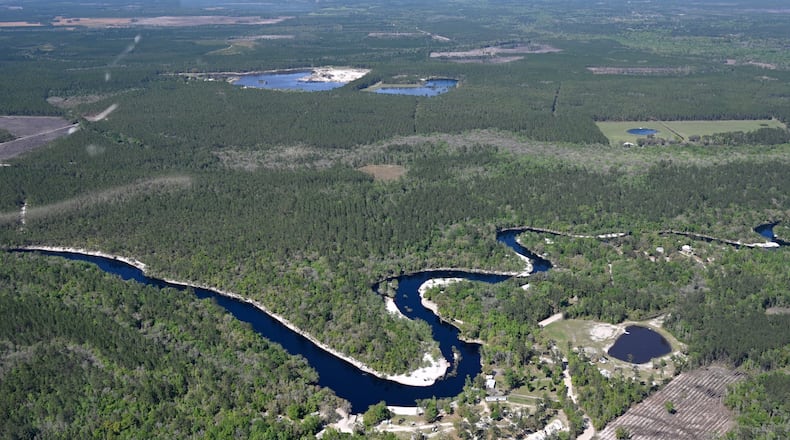In the final days of President Joe Biden’s administration, the federal government’s top wildlife official wrote Gov. Brian Kemp to warn that a mine planned at the edge of Georgia’s Okefenokee Swamp would threaten the fragile ecosystem.
In a letter dated Jan. 15 — five days before Biden left office — then-U.S. Fish and Wildlife Service Director Martha Williams told Kemp she was concerned about the mine’s potential effect on the swamp and the checkered environmental record of the company behind it.
In the letter, which was obtained through a Georgia Open Records Act request and has not been previously reported, Williams also pressed Kemp to back a proposal to conserve privately-owned land near the swamp, including property owned by the mining company.
“I urge you to exercise your leadership and authority as the governor of Georgia to help us achieve a mutually acceptable solution,” wrote Williams, who has since resigned from her role. The FWS did not respond to questions about the letter or whether the agency, now under President Donald Trump, still holds the same views.
Kemp’s office did not directly comment on the letter and instead referred questions about the mine to the Georgia Environmental Protection Division, citing its “independent” permitting process. A series of court decisions and settlements have placed permitting of the mine in the hands of EPD.
Credit: Ben Hendren for the AJC
Credit: Ben Hendren for the AJC
As Biden prepared to hand over the reins of the federal government, the note offers a glimpse into the outgoing administration’s 11th-hour push to keep the mine from becoming a reality.
Credit: HYOSUB SHIN / AJC
Credit: HYOSUB SHIN / AJC
The letter is not the first time a high-ranking member of the Biden administration has written to Kemp about the project. In 2022, then-Interior Secretary Deb Haaland wrote Kemp to urge the state to block the mine.
But Williams raised new questions about the company behind the mine itself, an Alabama-based firm known as Twin Pines Minerals.
Last year, an investigation by The Atlanta Journal-Constitution found Twin Pines and facilities linked to its owners had been cited for more than 70 violations in Georgia and three other states, accumulating more than $1 million in settlements and fines.
Williams did not point directly to the AJC’s reporting, but said information that has “come to light” about infractions by the company and its affiliates are concerning.
“Operation failures near Okefenokee — intentional or not — could cause irrevocable harm to the sensitive ecosystem,” Williams wrote. “We cannot afford that risk.”
Twin Pines has been angling for more than five years to extract titanium-rich sands from a site less than 3 miles from the Okefenokee National Wildlife Refuge. The location the company wants to mine sits on Trail Ridge, a line of ancient sand dunes that run along the swamp’s eastern flank that scientists say is key to the swamp’s hydrology.
Credit: Hyosub Shin/AJC
Credit: Hyosub Shin/AJC
The company owns thousands of acres on Trail Ridge and could seek to expand, but for now, it is seeking permits for a 584-acre “demonstration mine.”
Twin Pines has repeatedly said its hired experts' analyses show the mine will not harm the swamp. In response to the letter, Twin Pines’ president, Steve Ingle, reiterated the company’s position.
“We have spent millions on exhaustive studies by world renowned hydrologists, geologists, herpetologists and botanists to assure our operations will be safe and fully protective of the Okefenokee and surrounding environs,” Ingle said in a statement. “We stand by their conclusions with confidence and look forward to starting the mining-to-land-reclamation project as soon as possible and putting people to work in Charlton County.”
Charlton County is home to the proposed mine site and much of the swamp. Twin Pines has promised the project will bring hundreds of full-time jobs to the county, which has poverty rates roughly 9 percentage points above the state average.
EPD spokesperson Sara Lips did not directly respond to questions about Williams' letter and said there was “no update” on the status of the permits.
Josh Marks, the president of Georgians for the Okefenokee and a longtime opponent of mining near the swamp, praised Williams' outreach and said he hoped Kemp would work with FWS to reach a solution.
“This letter correctly highlights the scientific consensus that mining along the swamp’s hydrologic boundary is a terrible idea, but especially by a company in TPM (Twin Pines Minerals) which has violated the law around the country,” Marks said.
Credit: Hyosub Shin/AJC
Credit: Hyosub Shin/AJC
‘Permanent and irreversible impacts’
The federal government has been sidelined from any direct regulatory oversight of the mine, but FWS is still in charge of managing the 407,000-acre federal refuge inside the swamp.
The Okefenokee is home to red-cockaded woodpeckers, indigo snakes, wood storks and other threatened and endangered species, as well as vast stores of carbon-rich peat. The refuge is also set to be nominated to join the United Nations’ World Heritage List and would join globally renowned sites like the Great Barrier Reef, Machu Picchu and Yellowstone National Park, if selected.
FWS has warned EPD before that its hydrologists believe the mine could lower water levels in the swamp, increase the frequency of wildfires and risk “permanent and irreversible impacts” to the refuge. Other outside scientists have reached similar conclusions.
But so far, EPD seems to share the company’s view that the mine will not damage the ecosystem. Draft permits for the project were released almost exactly one year ago, but EPD has not given the project final sign-off.
Since then, opponents of the mine have tried to ratchet up pressure on Kemp to intervene to stop the project.
Credit: HYOSUB SHIN / AJC
Credit: HYOSUB SHIN / AJC
In the letter, Williams rehashed the FWS' environmental concerns, but also said she worries the mine could harm cultural artifacts.
The swamp is part of the ancestral homeland of the Muscogee (Creek) Nation, one of 574 federally recognized tribes. Trail Ridge, including the acreage Twin Pines wants to mine, was likely used as a travel corridor for the tribe’s ancestors, and burial mounds and other artifacts have been documented in the area. A survey conducted in 2020 on behalf of Twin Pines found no significant cultural resources on the property, but Williams said FWS suspects artifacts are present and could be damaged by the mine.
Williams also asked Kemp to support new efforts to grow the refuge’s footprint, potentially by acquiring land tabbed for the mine.
Last month, FWS finalized an expansion of the Okefenokee’s “acquisition boundary” — a move that does not immediately add land to the refuge, but would allow the agency to negotiate with nearby landowners to buy or conserve their properties. Twin Pines has expressed no interest in selling its land, but the 584-acre tract the company plans to mine was still part of the expansion.
Williams' letter concludes with an appeal to Kemp to head off the mining proposal to ensure the Okefenokee remains North America’s largest intact freshwater wetland.
“I understand that you also believe the Okefenokee is a treasure for the people of Georgia, the nation and the world,” Williams wrote. “The Fish and Wildlife Service remains committed to working with you to ensure that this place is protected for future generations.”
About the Author
Keep Reading
The Latest
Featured









